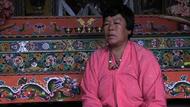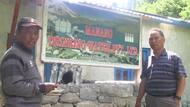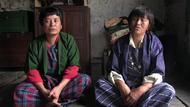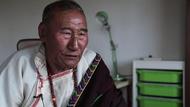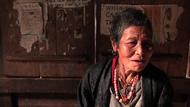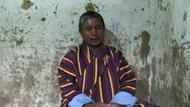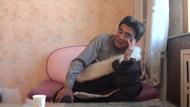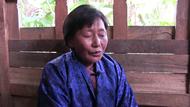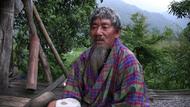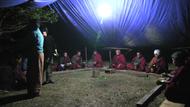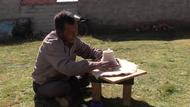Video Overview
Long-term Lhasa resident, Han Zuyun, talks about the history of Chinese businessmen from Beijing in Lhasa in the mid-20th century.
- Lhasa
- Beijing
- India
- སྤྱི་ལ་༡༩༤༡ལོར་ལྷ་སར་ཡོང་བ་རེད།I came to Lhasa in 1941.
- སྔས་མ་ནས་ལྷ་སར་པེ་ཅིང་ཚོང་ཁང་བསྐོར་ནང་ལ་བདུན་ཙམ་ཞིག་འདུག རྒྱ་རིགས་ཉི་ཤུ་ལྷག་ཙམ་རེད། ཚང་མ་པེ་ཅིང་ཚོང་ཁང་ཟེར་གྱི་རེད།There were about seven Chinese shops in Lhasa at the time, and they all were called Beijing Shop. About twenty Chinese [people] ran them.
- ང་དེ་དུས་ཡོང་དུས་ད་ལྟ་རྒྱ་ནག་ལ་ལམ་ཁ་ཡག་པོ་ཡོག་མ་རེད། རི་པིན་ (Ch.日本) དམག་ཆེན་གཉིས་པ་ཡིན་པའི་སྐབས་ལ་རེད། རྒྱ་གར་བརྒྱུད་ནས་ཡོང་བ་རེད།At that time, the roads were not good. And the war with Japan was going on. I went Lhasa through India.
- ཅ་ལག་བཏང་ཡོང་ནའི་འདུག་སེ་བྱས་བཏང་གི་ཡོག་རེད། ཅ་ལག་ཡོང་དུས་སྐབས་ལ་པེ་ཅིང་ནས་ཤང་ཀང་བྱས། ཤང་ཀང་ནས་ཀ་ལི་ཀ་ཏ་བྱས། འདུག་སེ་བྱས་ནས་ཀ་ལིང་སྦུག་ལ་རྟ་དྲེལ་བཞོན་ནས་སླེབས་ཡོང་གི་རེད།The goods followed the same the route. First, we sent them to Hong Kong from Beijing. And then they were sent to Calcutta and later to Kalimpong. From Kalimpong, we took them to Lhasa on the backs of the horses and mules.
- དེ་དུས་པེ་ཅིང་ཚོང་ཁང་དྲུག་བདུན་ཙམ་ལ་མིའི་ཉི་ཤུ་ལྷག་ཙམ་འདུག མི་ཞེ་དྲགས་ཡོག་མ་རེད། ད་ལྟ་པེ་ཅིང་ཚོང་ཚང་ཡིན་བཟོ་བྱས་ནའི་པེ་ཅིང་རང་གི་མི་མ་རེད། མང་ག་དེ་ཤང་ཤ་(Ch.乡下)དེ་འདྲས་རེད། པེ་ཅིང་གི་ལྷོ་ཕྱོགས་བ་དེ་འདྲས་རེད། ཧྲིན་ཀྲུའུ་བྱས། ཧྲུ་རུ་བྱས། ཡོའོ་ཡང་བྱས། ཇིང་ཤག་བྱས། དེ་གས་དེ་མང་བ་རེད། ཡར་མར་བྱས་ཨེར་ཧྲི་རྡོ་ཀ་རིན་ (Ch.二十多个人)There were only about twenty Chinese opened six or seven shops in Lhasa. There were hardly any Chinese. Although these shops were named Beijing Shop, they not owned by people from Beijing but Chinese from the countryside. Most of them came from south of Beijing. In total, there were only about twenty Chinese traders.
- (Ch.掌柜的) སྦྱིན་བདག་ལགས་བྱས་ན་པེ་ཅིང་ལ་བཞུགས་ནས་ཅ་ལག་ཉོ་བྱས་ཚུར་བཏང་གི་ཡོག་རེད། འདི་མང་བ་དེ་ལ་ཚོང་དྲུང་དང་། ང་ཡང་ཚོང་དྲུང་བྱས་ནས་ཡོང་བ་རེད། མི་མཉམ་དུ། ཨཱ་ནི་ཞུགས་མ་ག་ལེར་ག་ལེར་བྱས་ལོ་མང་པོ་བསྡད་སྦྱིན་བདག་ལྷ་སར་མ་ཡོང་བ་བྱས། ལྟ་སྦྱིན་བདག་གི་ཚབ་བྱས་ནས་ཚོང་ཁང་ནང་ལ་བསྡད་པ་རེད།The principal owner of our shops lived in Beijing. The owner gathered the goods and then sent them to us. Most of us came as trade secretaries; I was also one of them. After spending many years in Lhasa, I managed the shop for the real owner, who stayed behind in Beijing.
- སྔས་ལ་ལྷ་སར་ཚོང་ག་རེ་བརྒྱབ་པ་ཡིན་བྱས་པ། མང་བ་དེ་ལ་གྲུའུ་རྩེ་ (Ch. 绸子) གོས་ཆེན་བྱས། དཀར་ཡོལ་བྱས། སི་ཤན་(Ch.丝线)ཡོ་ཆས་བྱས། ཡང་དེ་ལ་དུང་ (Ch.铜) ཟངས་ཀྱི་མནྜལ་དང་འདི་འདྲ་སེ་བྱས་ནས་ཁྲོའི་ཅོའུ་བྱས། དེ་འདྲས་བྱས་ནས་མང་བ་ཅ་ལག་འདི་གས་ཡོང་གི་ཡོག་རེད།Goods imported from China and sold in Lhasa mainly included silk cloths, Chinese porcelains, copper products, etc.
- དེ་དུས་ལམ་ཁ་ལ་ཞེ་དྲགས་འགོར་གྱི་འདུག ལོ་རེ་རེ་ལ་ཕལ་ཆེར་ཐེངས་མ་གཉིས་ཙམ་མ་གཏོགས་ཡོང་ཡག་ཡོག་མ་རེད་ཅ་ལག དབྱར་ཁ་ཅ་ལག་དགུན་ཁ་ལ་ཡོང་། དགུན་ཁའི་ཅ་ལག་དབྱར་ཁ་ལ་ཡོང་། འདུག་སེ་ཡོང་གི་འདུག ལམ་ཁ་ལ་རྦད་དེ་ཟླ་བ་གསུམ་བཞི་ཙམ་འགོར་གྱི་འདུག་ག ལམ་ཁ་ལ་ཁག་པོ་ཞེ་དྲགས་འདུག དེ་འདྲས་བྱས་ནས།The journey to Lhasa takes months. We could make only two trips to the city per year. So the winter products bought in during the summer. And summer goods were brought in during the winter. The roads were treacherous, and it would take three to four months.
- ང་དེའི་ཞུ་གུ་ལ་བོད་ལ་རིང་པོ་བསྡད་པ་ཡིན་ཙང་སྔོན་མ་ནས་ཚོང་ཨོའོ་ཙམ་འདུག སྔས་མ་སྤྱི་ཚོགས་སྙིང་པའི་སྒང་ལ་ད་ལྟ་མིང་ཕད་ཟེར་མཁན། ལྟ་ལམ་ཁ་བར་བསྐོར་དཀྱིལ་དེ་ལ་ཡོག་རེད་པ། ལྷ་ས་ལ་ཏིག་ཙམ་ལས་ཡོག་མ་རེད། ད་ལྟ་ནང་ཡེའེ་བརྒྱུད་གཏོང་ཧང་ཡད་དེ་འདྲ་ཡོག་མ་རེད། ཚོང་ག་རེ་རྒྱག་དགོས་ཀྱི་ཡོད་ནའི་སོ་སོའི་འདོད་པ་རེད། ཁྲལ་རྒྱག་ཡག་ཡེ་ཙམ་བྱས་ན་གལ་ཡོག་མ་རེད།Since I stayed in Tibet for a long time, the business was quite good. We were selling in the middle of barkor street in Lhasa, at the time, the city was quite small. You pay your tax, and you can trade anything you wished.
- ད་ལྟ་ལ་ལྷ་ས་ལ་དེར་ང་དང་པོ་ཡོང་དུས་ཙམ་གྱི་ཁང་པ་ད་ག་ལ་བསྡད་པ་རེད། དེ་ནས་མར་ལྷེའུ་ཤག་གཟིམ་ཤག་རེད། ཞུགས་མ་ལ་༡༩༥༣ལོ་ལ་བཙོངས་ཀྱི་ཡིན་སེ་བྱས་ནས་ངས་ཉོས་བཞག་པ་རེད། སྤུ་གུ་དང་ཨ་ལྕེ་གང་ག་བོད་རིགས་སོང་ཙང་འོ་འདུག་སེ་བྱས་ནས་ཉོས་བཞག་པ་རེད།I am living in the same house when I first came in. The house initially owned by Liushag Family. In 1953, they decided to sell it. So I bought it from them since my wife and children are all Tibetans.
- སྔས་མ་ཡིན་ན་བོད་ལ་སྤྱི་ཚོགས་སྙིང་པ་ལ་རྒྱ་རིགས་དང་། བལ་པོ་དང་། དེ་འདྲས་སེ་བྱས་ནས་ཡང་ཁང་པ་ཉོས་ཆོག་གི་མ་རེད། འདའི་ཞུགས་མ་ལ་ལྟ་ག་རེ་ཟེར་གྱི་རེད། ཧའ་བིན་ཇེ་ཕྷང་ (Ch.和平解放)བྱས་ནས་ན་འགྱུར་ལྡོག་ཞེ་དྲག་བྱས་ཀྱི་མི་འདུག ཡིན་ནའང་སོ་སོས་ཨ་ལྕེ་མིང་བརྒྱབ་ན་འགྲིག་གི་ཡོག་རེད། འདི་འདྲས་རེད་དེ་དུས།In the odd days, the Chinese and Nepalese were not allowed to purchase a home in Lhasa. After the "Peaceful liberation of Tibet," nothing much changed. However, you were allowed enlist your wife's name.
- ལྷ་ས་ལ་བར་བསྐོར་ནང་ཚོང་པ་མང་བ་དེ་བར་བསྐོར་ནང་བསྡད་ཀྱི་འདུག བར་བསྐོར་ནང་ལ་བྱང་ཕྱོགས་དེར་མང་བ་བལ་པོ་རེད། དེ་དུས་དངོས་གནས་བྱས་ན་ཚོང་ཆེན་པོ་བརྒྱབ་མཁན་དེ་ལ་བལ་པོས་ཚོང་ཆེན་པོ་བརྒྱབ་ཀྱི་འདུག གསེར་དང་། དངུལ་དང་། ཐེར་མ་དང་། རས་ཆ་དང་གང་ག་བལ་པོ་རེད།Most of the traders stay around the Barkhor. On the northern sides, most the traders were Nepalese. During those days, they were the ones who were doing big business. The dominated the trade in gold and silver products as well as silks and textiles.
- བར་བསྐོར་ནང་ལ་ཡང་དེ་མིན་པ་མང་བ་དེ་ལ་ཁ་ཆེ་མང་ག་རེད། ཁ་ཆེ་ཚོང་ཆུང་ཆུང་བརྒྱབ་ཀྱི་འདུག ཁོ་རང་ཚོ་ཡང་སྦྱིན་བདག་སེ་བྱས་དེ་འདྲས་ཡོག་མ་རེད། ལྟ་གང་ག་ནང་མི་འདི་འདྲས་བྱས་བར་བསྐོར་ཤར་དང་ལྷོ་ལ་མང་བ་ཁ་ཆེ་རེད། ཁོ་རང་ཚོ་ལ་རྒྱ་གར་ཅ་ལག་ཉོ་ག་འགྲོ་གི་འདུག ལོ་གསར་ལ་ཁྲོམ་བཏོན་ནས་བཙོངས་ཀྱི་ཡོག་རེད།Then in the Barkhor, many of the traders were Muslim traders. They did business on a small scale, and they didn't serve any master. All were family-owned business. They would stay mostly on the east and south of Barkhor. Before Tibetan New Year, they would bring Indian products to sell.
- དེ་དུས་ལྷ་ས་ནང་ས་ཆ་ཏིག་ཙམ་ལས་ཡོག་མ་རེད། སྔས་མ་སྐད་ཆ་བྱས་ན་ཁྲི་གསུམ་ཙམ་ཡོད་ཟེར་གྱི་འདུག་ག ལྟ་ཤར་ཕྱོགས་ལ་བྱས་ན་དེ་ཐལ་སྦུར་སྒང་རྒྱ་ལྷ་ཁང་བར་དུ་མི་སེ་ཡོག་མ་རེད། མི་ཚང་སེ་ཡོག་མ་རེད། ནུབ་ངོས་ཕྱོགས་དེ་ལ་སྔས་མ་འདིའི་རྩ་ལ་ཀླུ་བུ་རྒྱལ་སྒོ་སེ་གཅིག་འདུག འདི་འདྲས་ཡང་མར་ཕྱི་ལོགས་ལ་གང་ག་སྤྲང་ཚང་དེ་འདྲས་ཤ་སྟག་རེད། འདའི་གཏོར་རྒྱག་གཏོང་ས་དང་གཅིག་དང་། བྱང་ངོས་ཕྱོགས་དེ་ལ་་་མཚན་ཉིད་ཤོད་ས་རེད། དེ་གླིང་བསྐོར་ལམ་ཁ་ཕྱི་ལོགས་འདི་མ་གཞི་ཡོག་མ་རེད། མང་ཤོས་ཕར་ཕྱོགས་བྱང་ངོས་ཕྱོགས་དེ་རེད། ར་མོ་ཆེ་བར་དུ་འདུགAt the time, the city was tiny and claimed to had a population of about thirty thousand people. On the east side, there were hardly any families beyond the Gya temple. On the north side, there was Lhubu gate. Beyond those points were populated by beggars. There was a place where torma cake was thrown and also a debating site for monks. The city population was largely concentrated on the northern side up to the Ramoche Temple.
- ལྟ་ད་ལྟ་ལ་བཅིངས་འགྲོལ་བཏང་ཚར་པ་རྗེས་འཇུག་ལ་བྱས་ན་ཡར་རྒྱས་ཞེ་དྲགས་ཕྱིན་པ་རེད། མི་ཡང་མང་པོ་ཡོང་གི་རེད། ཡར་རྒྱས་ཕྱིན་ནས་ད་ལྟའང་དང་པོ་ནས་ཞེ་དྲགས་ཡོག་མ་རེད། གཙོ་བོ་ཆེ་དེ་ལ་༡༩༨༠ཏང་གི་སྐབས་བཅུ་གསུམ་པའི་ཚོགས་འདུའི་(Ch. 十一届三中全会)རྗེས་ལ་ཁལ་ཕྷང་ (Ch. 开放) བྱས་ནས་མི་ཡང་མང་དུ་ཕྱིན་པ་རེད། ཚོང་ཁང་མང་དུ་ཕྱིན་པ་རེད། བཟའ་ཡང་དང་འཐུང་ཡག ལྟ་ལམ་ཁ་གཉིས་བཟོས་ཚར་པ་རེད་པ། མཚོ་བོད་གཞུང་ལམ་དང་འདི་སྒང་ལ་ཕྷི་ཅི་ (Ch. 飞机)དང་། དེའི་སྒང་ལ་ལམ་ཁ་བདེ་པོ་ཞེ་དྲགས་འདུག ཡར་མར་འགྲོ་མཁན་མི་མང་པོ་འདུགAfter the "liberation," the city made significant progress and population also increased considerably. The development was made only after the Third Plenary Session and not much before that. After opening up, the city population increased. Along with that, the number of shops increased, and food supplies also grew. Two highways were also completed, like the Qinghai-Tibet Highway, and airports were built. And the roads [were made] very smooth too.
- ལྟ་ད་ལྟར་ཡར་རྒྱས་ཕྱིན་པ་དེ་ཚོ་བཤད་ཤེས་ཀྱི་མི་འདུག ལྡབ་མང་པོ་ཡར་རྒྱས་ཕྱིན་པ་རེད། ད་ལྟ་ཀྲུང་དབྱང་གི་འགོ་ཁྲིད་ལ་བལྟས་པ་ཡིན་ན་ཀྲུང་དབྱང་དེ་འདྲས་རྒྱག་དགོས་ཀྱི་རེད། དེ་འདྲས་བརྒྱབ་པ་རེད། དེ་བྱས་ན་སེ་ང་ཚོས་འདི་འདྲས་ཤེས་ཀྱི་ཡོག་མ་རེད་པ། གང་ག་སོ་སོ་མིག་མཐོང་གི་གང་ག་ལོག་རྒྱ་ཆེན་པོ་ཞེ་དྲགས་ཆགས་འདུག་གIt is hard to put into words those improvements. The city developed manifold. People like me can't make those changes and developments as the government cadres can do, we are telling those big changes we witnessed with our own eyes.
- ཕར་ཕྱོགས་མདོ་སྡེའི་ལམ་ཁ་དང་། ཉང་ར་ལམ་ཁ་ས་ཆ་སྟོང་པ་ཁྱོན་ནས་ཡོག་མ་རེད། ཕར་ཕྱོགས་ས་རག་བར་དུ་བྱས་དེ་ཕྱོགས་བྱས། ད་ལྟ་དེའི་རྒྱབ་ལ་ཐག་རིང་པོ་ཞེ་དྲགས་སླེབས་ཡག་འདུག་གNow there are hardly any spaces left on the sides of Duodi and Nangra roads. The city has expanded greatly.
- སྔས་མ་ནས་དེ་ལ་ལྷ་ས་ནས་འབྲས་སྤུངས་ལ་འགྲོ་གི་ཡོད་ན་བར་རྩ་ལ་གང་ག་འདམ་ར་ཤ་སྟག་རེད། རྩ་ཐང་འདི་གས་དང་དེའི་ཞུགས་གོ་ལ་སྤང་རེད་པ། སྔས་མ་གང་ག་ལ་འདམ་རྩ་རེད། དེ་འདྲ་བྱས་ནས་རྟ་བཞོན་ནས་འགྲོ་གི་ཡོག་རེད།In the old days, if you traveled between Lhasa and Drepung monastery, a vast portion of the land in between was covered with grass or swamp.
- ལྟ་ད་ལྟ་ག་པར་འགྲོ་ནའི་སྤྱི་སྤྱོད་རླངས་འཁོར་(Ch.公共汽车)བྱས། ག་རེ་བྱས་ནའི་ཞེ་དྲགས་མང་དུ་ཕྱིན་པ་རེད་པ། བཟའ་ཡག་འཐུང་ཡག སྔས་མ་ཚལ་ཡིན་ནའི་ཤ་ཡིན་ནའི་ཤ་རུང་བར་ལ་རེད། དེ་མ་གཏོགས་ཡོག་མ་རེད། ཤ་རུང་བར་ལ་ཤ་ཁང་སྔས་མ་རྙིང་པ་དེ་ཡོག་རེད་པ། སྔས་ཀྱི་ཙོང་ཡག་གང་ག་དེར་ཡོག་རེད། ཞུ་གུ་ལ་ཁང་པ་དེ་ཡོག་མ་རེད།Now wherever you want to go, you can commute in public buses with ease. Food supplies have increased greatly. Before, the meats and vegetables were sold only at Sharung area, where there was one meat shop. That's was the only place to buy, and there wasn't much on sale. That shop no longer exists.
- ད་ལྟ་ཚལ་བཙོངས་ས་འདི་ལ་ཤ་རུང་བར་ལ་དང་དེའི་བར་རྩ་ལ་ཏིག་ཙམ་ཏིག་ཙམ་ལས་ཡོག་མ་རེད། ཚལ་དེ་དུས་བཙོངས་ཡག་ཞེ་དྲགས་མི་འདུག ཉོ་མཁན་ཡང་ཞེ་དྲགས་མི་འདུག ང་ཚོ་བོད་པའི་ལུགས་སྲོལ་ལ་དེ་དུས་ཚལ་ཞེ་དྲགས་ཟ་གི་མེད་པ་འདྲ།The vegetables were also sold at the Sharung area, and there were few varieties. There were only a few sellers and buyers. In our Tibetan custom, we don't eat vegetables that much.
- ཡང་ཕིང་དང་། སྒོ་ང་དང་། ཤ་འདི་འདྲས་གཙོ་ཆས་འདི་འདྲ་དང་། རྩམ་པ་དང་། ལྟ་དེང་སང་གང་ག་གནམ་གྲུ་ (Ch.飞机)དང་མོ་ཊོ་ལ་ (Ch.汽车)འཁྱེར་ཡོང་གི་འདུག་ག ཚལ་སྣ་མིན་སྣ་ཚོགས། ཧ་ལམ་རྒྱ་ནག་ནང་བཞིན་ཆགས་བཞག འདི་འདྲས་ཤིང་ཏོག་དང་། སྔས་མ་ཤིང་ཏོག་ཁྱོན་ནས་ཡོག་མ་རེད། ཚ་ལུ་མ་དང་འདི་འདྲས་ཏོག་ཙམ་འདུགMainly they eat vermicelli, eggs, and meats along with tsampa or parched barley flour. Nowadays, everything is transported here by air and land routes. There are wide varieties of vegetables are available. The city has almost become a Chinese city. There are also various fruits. There were hardly any fruits before, such as oranges.
- དབྱར་ཁ་ལ་སྟོན་ཁ་སྒང་ལ་་་་ཁམ་བུ་དང་འདི་དྲས། ག་རེ་ཟེར་གྱི་རེད། མངའ་རིས་ཁམ་བུ་ག་རེ་ཟེར་གྱི་རེད། ལྷ་ས་ཐོན་པ་དེ་འདྲས་འདུག་མ་གཏོགས་ཤིང་ཏོག་གཞན་པ་སེ་ཡོག་མ་རེད། ལྟ་ད་ལྟ་ནང་བཞིན་ཤིང་ཏོག་དང་། ཀུ་ཤུ་(Ch.苹果)དང་ལི་དང་ག་རེ་ཉོ་ཉོ་རེད། ངང་ལག་(Ch.香蕉)དང་། ཨ་ནའི་འབྲས་བུ་(Ch.菠萝)དང་འདི་བྱས་ནས།During the summer and autumn, there were dried peaches. Besides those, there were hardly any other fruits available like we have them now, like apples, peaches, bananas, and pineapples, etc.
- ཚོང་བྱས་ན་སྔས་དང་བསྡུར་ན་ད་ལྟ་ཞེ་དྲགས་ཡག་ག མི་མང་པོ་རེད་པ་ཡར་མར་མང་པོ་བྱས། དངུལ་ཡང་མང་དུ་ཞེ་དྲགས་ཕྱིན་པ་རེད། ལྟ་སྤྱི་ཚོགས་རྙིང་པ་སྒང་ལ་མི་སེར་སྡུག་པ་དང་དེ་འདྲ་སེ་བྱས་ནས། ཞུ་གུ་བཅིངས་བགྲོལ་བཏང་ཚར་བ་ཞུགས་ལ་མ་གཏོགས་དེ་འདྲས་འགྱུར་ལྡོག་སེ་ཞེ་དྲགས་བྱས་མེད།With increased population and disposable income, the business is much better than before. In the old days, the people in the city were impoverished. Things got much better after the "liberation."
- འདི་འདྲས་འདུག་པ་དང་། མི་སེར་ལྟ་སྐྱོ་པ་ཤ་སྟག་རེད། དེ་དུས་མི་སེར་ལའང་མཐུན་རྐྱེན་དེ་ལས་ཡོག་མ་རེད། སྐུ་དྲག་ལ་ཟ་ཡག་བྱས་ནའི་དེར་འདྲས་སེ་ཡོག་མ་རེད། དེ་དུས་བོང་བུ་རེད་པ། ནམ་རྒྱུན་ལྟ་དེ་ཤ་སྟག་མཐོང་གི་འདུག ཨ་ལས་གཟིམ་ཤག་དེ་ཚོ་སྒོ་མ་ཕྱེ་གོང་ལ་ཞིང་པ་ལ་བོང་བུ་དེ་ཚོ་གང་ག་སྒུག་བསྡད་ཀྱི་འདུག ཟམ་པ་དང་ཇོའོ་(Ch.桥)དང་། སྒོ་ང་བྱས་རྩམ་པ་བྱས་ཛར་ཛོར་དེ་འདྲས་ཤ་སྟག་ཡིན་པ་འདྲ།All ordinary people were impoverished and got no facilities. Even the nobility did not have a variety of food choice. Basically, at the time everyone was poor. Every morning, I could often see a group of people with their donkeys waiting near the bridge for the doors of the nobility to open. I think they brought with them tsampa, eggs, other miscellaneous goods as a tribute.
- འདི་འདྲས་ཞན་པ་སེ་མི་འདུག མི་སེར་སྐྱོ་པོ་རེད། དཔོན་པོ་ལ་ཕུལ་ཡག་ཞེ་དྲགས་ཡོག་མ་རེད། ད་དུང་ཡང་བུ་ལོན་ཞེ་དྲགས་བཟོ་གི་འདུག་ཟེར་གྱི་འདུག་ག ད་ལྟ་བཤད་མི་དགོས་པ་བསྡུར་ས་མེད་(Ch.没法比喻了. 现在说起来. 现在庄稼)དེང་སང་བཤད་ན། སྟོན་ཐོག་ཀྱང་ཧ་ཅང་ཡག་པོ་འདུག སྔས་མ་ཡིན་ན་དེ་འདྲས་ཡོག་མ་རེད། ཞིང་ཁ་དང་།Since the people were very poor, they didn't have much to present the officials. But still, I heard that they had heavy debt loads. Nowadays, things are way better. There is no comparison. The crop yields are also excellent, not like the old days.
- པེ་ཅིང་ཚོང་ཁང་བདུན་མ་གཏོགས་ཡོག་མ་རེད་པས།Were there only seven Beijing shops?
- བདུན་ལས་ཡོག་མ་རེད། དེའི་ང་ཚོ་དང་མཉམ་དུ་གསུམ་འདུག ཟུར་ཁང་འོག་དེར་གཅིག་འདུག བསམ་གྲུབ་ཕོ་བྲང་འོག་དེར་གཅིག་འདུག སྒོ་མང་ཧ་སང་འོག་དེར་གཅིག་འདུག ་་་འོག་དེར་གཅིག་འདུག ཚོང་ཁང་བདུན་བྱས། མི་ཉི་ཤུ་ལྷག་ཙམ་འདུགYes, only seven shops. Three them were close to ours. There was one under Samdup Phodrang. And another one at Gomang Hasang. In total, they were only seven shops with about twenty Chinese traders.
- ཅ་ལག་ཚོང་ཡག་ཚང་མ་ཆ་རེད་པས།Were they selling the same goods?
- ཅ་ལག་འདྲ་པོ་འདྲ་པོ་རེད། (Ch. 差不了. 做的生意一般呢. 比较大呢. 一般是都是干什么呢是我们的...做的生意不大.) དཀར་ཡོལ་དང་གཅིག་དང་ཡོད་པ་ང་ཚོ་ཚོང་ཁང་གཉིས་ལ་མ་གཏོགས་ཡོག་མ་རེད། དེ་དུས་ཁེ་སང་ཡང་ཆེན་པོ་འདུག དེ་ཁྱེར་ཁག་པོ་ཞེ་དྲགས་འདུག་ག ལམ་ཁ་ལ་ཞེ་དྲགས་ཆགས་ཀྱི་འདུགWe sold similar goods. However, we were one of the two shops that sold chinaware. That was the most profitable good then. They were also hard to transport. Many broke on the way.
- ཅ་ལག་དེ་གས་ཚང་མ་ཁྱེད་རང་གི་ལུང་པ་ནས་ཁྱེར་ཡོང་བ་རེད། ས་ཆ་གཞན་དག་ནས་ཁྱེར་ཡོང་བ་རེད།From where did you buy these goods?
- ཅ་ལག་གཞན་དག་ནས། ལྟ་དཀར་ཡོལ་ཉོ་ས་ཡང་ཅང་སུའུ་(Ch. 江苏) རེད། ཧྲང་ཏུང་ (Ch. 山东)ནས་གྲོའུ་རྩེ་ ཡང་དེ་གས་པེ་ཅིང་ནས་ཉོ་གི་ཡོག་རེད། པེ་ཅིང་ལ་ཁྱེར་ཡོང་ནས།The porcelain was bought in Jiangsu, and silks from Sandong. They were also bought in Beijing.
- སྦྱིན་བདག་ཁོ་ར་པེ་ཅིང་ལ་བསྡད་ཀྱི་ཡོག་རེད་པས།He lived in Beijing?
- སྦྱིན་བདག་པེ་ཅིང་ལ་བསྡད་ཀྱི་ཡོག་རེད།The owner lived in Beijing.
- སྦྱིན་བདག་པེ་ཅིང་མི་རེད་པས།Was the main ower was from Beijing?
- པེ་ཅིང་གི་མི་མ་རེད་སྦྱིན་བདག་ཡང་ཕ་ཡུལ་གཅིག་པ་རེད། (Ch. 乡下老乡)པེ་ཅིང་གི་ཚོང་ཁང་བྱས་ན་མ་གཏོགས་པེ་ཅིང་རང་གི་མི་ཡོག་མ་རེད།The owner was not from Beijing. He was from my hometown. Although the shops were called Beijing Shop, but the owners were not from Beijing.
 Loading ...
Loading ... 